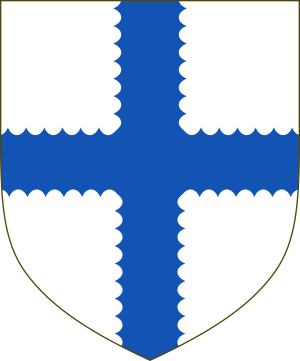Henry Sinclair, 4th Lord Sinclair facts for kids
Quick facts for kids
Henry Sinclair
|
|
|---|---|
| Lord Sinclair | |

Lord Sinclair coat of arms
|
|
| Predecessor | William Sinclair, 3rd Lord Sinclair |
| Successor | William Sinclair, 5th Lord Sinclair |
| Died | 1513 |
| Noble family | Clan Sinclair |
| Father | William Sinclair, 3rd Lord Sinclair |
| Mother | Christian Leslie |
Henry Sinclair (died 1513) was an important Scottish noble. He held the title of the 4th Lord Sinclair. Some old books, like The Scots Peerage, called him the 3rd Lord Sinclair. However, other historians, like Roland Saint-Clair and Bernard Burke, say he was truly the 4th Lord. They based this on an old Scottish Parliament record. This record showed his family line went back to his great-grandfather, Henry II Sinclair, Earl of Orkney, who was the very first Lord Sinclair.
Contents
Early Life and Title
Henry Sinclair was the son of William Sinclair, 3rd Lord Sinclair and Christian Leslie. His mother was the daughter of George Leslie, 1st Earl of Rothes. After his father passed away, the Scottish Parliament made an official statement. This statement, from January 1489, recognized Henry as the "Chief of that blood." It also said he should be called "Lord Saintclair from now on." This act didn't create a new title. Instead, it confirmed that the title of Lord St. Clair already existed through his ancestor, Henry II Sinclair, Earl of Orkney.
Important Jobs and Roles
Henry Sinclair, the 4th Lord Sinclair, became a member of the Scottish Parliament on January 14, 1488. This meant he had a say in important decisions for Scotland. On December 4, 1488, he and his wife, Margaret, received official ownership of several lands. These included Cousland, Ravenscraig (with nearby Woolston), Carberry, and Dubbo.
Looking After Orkney and Shetland
Lord Sinclair was often involved in managing the Orcadian islands. He was a "Tacksman" of the Isles. This meant he leased land from the King and then rented it out to others. In 1485, he gave money every year to the Bishop of Orkney. In May 1489, Lord Sinclair received a 13-year lease for Orkney and Shetland. He also gained control of Kirkwall Castle and other forts. He was given the power to act as a judge and administrator for these islands for 13 years. It's also likely he helped pass a law in 1503. This law stopped foreign laws from being used in Orkney and Shetland. It made sure the native laws of the islands were protected. In 1503, he also gained ownership of lands in Newburgh.
Master of Artillery and the Great Michael
On March 13, 1510, Lord Sinclair was made the Master of the Artillery. This was a big job, and he earned £100 a year for it. This money was taken from his Orkney accounts. His main home was Ravenscraig Castle. He was also the captain of Scotland's main warship, the Great Michael, in 1512. This was a very large and impressive ship for its time.
Before he died, he sold eight cannons to the King for £100. This money was later paid to his wife. Henry Sinclair was killed in a major battle called the Battle of Flodden on September 9, 1513.
His Family
Henry Sinclair, 4th Lord Sinclair, married Margaret. She was the daughter of Adam Hepburn, Master of Hailes and sister of Patrick Hepburn, 1st Earl of Bothwell. They had several children:
- William Sinclair, 5th Lord Sinclair: He was their oldest son and took over his father's title.
- Catherine Sinclair: In 1512, she married Sir David Wemyss of Wemyss. Their family later became the Earls of Wemyss.
- Helen Sinclair: She married James Ogilvy, 4th Lord Ogilvy of Airlie.
- Jean Sinclair: She married Sir Alexander Lindsay, Master of Crawford. He was the son of David Lindsay, 8th Earl of Crawford.
- Agnes Sinclair: She married Patrick Hepburn, 3rd Earl of Bothwell.
- William Sinclair: He was a son born outside of marriage. He was later made legitimate in 1540. He became a Chaplain and Vicar.
See also

